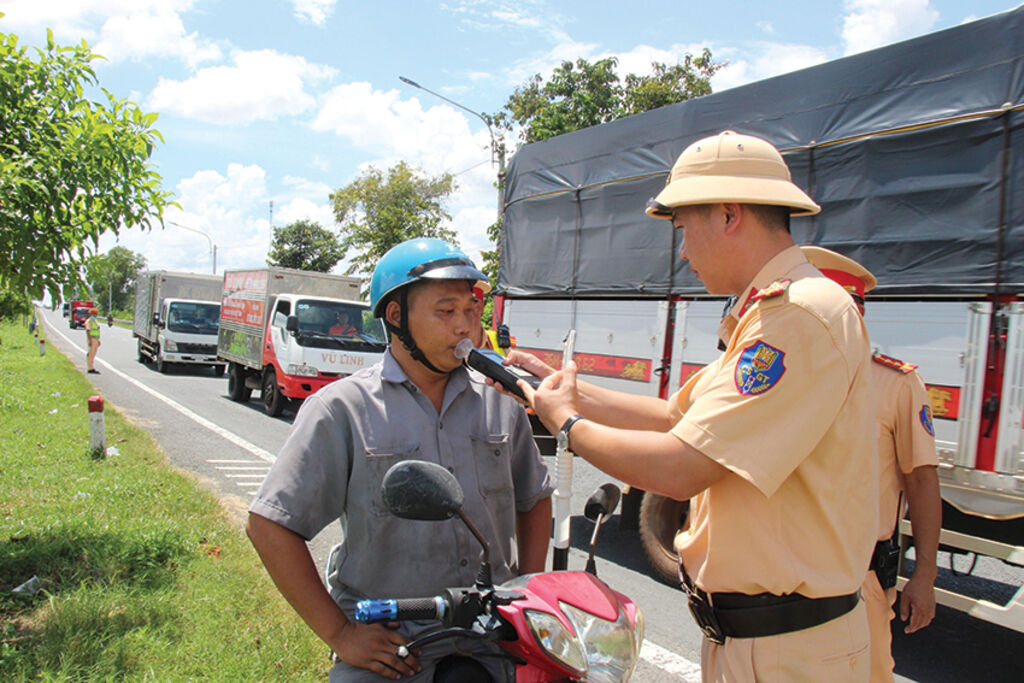 |
| A motorbike rider is taking a breath alcohol test__Photo: VNA |
Drunk driving or driving under the influence of alcohol (DUI) is one of the top causes of traffic accidents in almost countries around the world and Vietnam is no exception.
In a recent seminar titled “The impact of alcohol and beer on road traffic participants” jointly held by the Department of Traffic Police (Ministry of Public Security) and the Department of Medical Service Administration (Ministry of Health), authorities revealed that in 2023, the national traffic police force handled 770,679 cases of DUI and, from June 2022 to December 2023, alcohol-related road traffic accidents caused 3,427 deaths and injured 4,327 people. Economic costs associated with beer consumption in Vietnam were nearly USD 3.4 billion, equivalent to 3 percent of the total national budget revenue. Social surveys revealed that over half of prisoners had consumed alcohol or beer before committing crimes.
Vietnam is now applying the absolute sobriety law to all drivers. Under the 2019 Law on Prevention and Control of Harms of Liquor and Beer Abuse, the act of “operating road vehicles with alcohol concentration in blood or breath” is prohibited. In other words, the permissible alcohol content for drivers is zero and it is illegal to drive after consuming any amount of alcohol. In order to enforce the law, the Government issued Decree 100/2019/ND-CP on sanctioning administrative violations in the field of road and railway traffic, imposing heavy penalties on drunk driving and DUI.
Noteworthily, Decree 100 does not provide any limit of detection of alcohol in blood or breath. It instead sets alcohol concentration thresholds for imposing different fine levels. Specifically, car drivers with alcohol concentration below or equal to 50mg per 100ml of blood or 0.25mg per liter of breath will be fined VND 6-8 million (USD 250-330). Those with alcohol concentration exceeding 80mg per 100ml of blood or 0.4mg per liter of breath will be subject to the highest fine of VND 40 million (USD 1,650) and have their driver’s licenses revoked for up to 24 months, given that the highest fine level under the old regulation governing drunk driving was merely VND 18 million (USD 750). For those who operate motorbikes, bicycles or other rudimentary vehicles, the fines are lower but the alcohol concentration thresholds remain the same.
According to statistics from the Ministry of Public Security, controlling DUI violations among drivers is proven very effective. In 2023, alcohol-related traffic accidents decreased by 25 percent, with a 50-percent drop in deaths and a 22-percent fall in injuries, compared to the 2022’s figures.
The Government is now working on the draft Law on Road Traffic Order and Safety and when the draft law is tabled to the National Assembly for debate and released to the public, one of the matters of great concern to both legislators and people is whether the zero tolerance law should be applied to all drivers or a certain blood alcohol level should be accepted in certain cases.
A maximum permissible alcohol content - why and why not?
National Assembly deputy Nguyen Quang Huan from the southern province of Binh Duong wondered about the feasibility and scientific grounds of the absolute sobriety law.
“In my opinion, it is quite unrealistic to impose an absolute sobriety requirement on all drivers. In the world, some countries require a blood alcohol content of zero while some others provide a maximum permissible blood alcohol level when driving which ranges from the limit of detection of 0.08mg per 100mg of blood. Hence, we should undertake specific researches and evaluations,” Huan shared his viewpoint with the Tuoi Tre.
Assuming the alcohol content measured immediately after drinking a can of beer is equivalent to 0.02mg per liter of breath, the Ministry of Public Security should, for example, take the figure of 0.02mg as a threshold and compile statistics on the percentage of alcohol-related traffic accidents involving drivers with alcohol concentration exceeding that threshold. In case drivers’ alcohol content in most traffic accidents is higher than 0.02mg per liter of breath, such threshold can be considered the maximum permissible alcohol content when driving. If there are many traffic accidents involving drivers with alcohol content equal to or smaller than 0.02mg per liter of breath, the absolute sobriety law should be further applied. “This is a scientific ground that needs to be taken into consideration,” Huan suggested.
According to doctor Nguyen Huy Hoang from the Vietnam-Russia Hyperbaric Oxygen Center (Ministry of National Defense), from a medical perspective, there is a small amount of alcohol produced in human body through the process of metabolism and natural fermentation of food. However, current legal documents remain silent about naturally occurring sources of alcohol within the body.
“For the time being, there remains a hot debate about whether or not alcohol naturally exists in the human body. Some people said they do not consume alcohol but still fail the breath alcohol test,” Hoang said.
The Ministry of Public Security, the agency in charge of drafting the Law on Road Traffic Order and Safety, holds the opinion that the absolute sobriety law should be further applied due to the traffic conditions and alcohol consumption culture in Vietnam.
In a recently released explanatory document on some new points of the draft Law on Road Traffic Order and Safety, the Ministry of Public Security cited the Ministry of Health’s statistics, stating that Vietnam is the second-highest consumer of alcohol and beer in Southeast Asia, ranks 10th in Asia and 29th worldwide.
Against this backdrop and given the “unique” traffic conditions in Vietnam, it is extremely necessary to maintain the absolute sobriety law so as to help ensure traffic safety and social order.
“Traffic conditions in Vietnam are different from those in developed countries, where cars travel in separate lanes and at distances appropriate to their speed, giving drivers about half a second to recognize an emergency situation and another haft a second to react. Thus, when a driver violates the law and causes an accident, the chance of multi-vehicle collision would be reduced. For Vietnam to achieve that, cars traveling at 40 kph should maintain a distance of over 22 meters between them, which is unimaginable in Vietnam, where vehicles are only a few meters apart at 40 kph,” the ministry analyzed. “Traffic on the roads in Vietnam requires drivers to maintain alertness and quicker reflexes many times over in case of sudden situations,” the ministry underlined.
“Moreover, if there was any permissible limit, people will keep drinking. Alcoholic beverages are addictive, and once started, it is not easy to stop. Once intoxicated, it becomes difficult to remember what the law stipulates,” the document states.
Many legislators and experts agreed with the Ministry of Public Security’s point of view.
According to Bui Hoai Son, a permanent member of the National Assembly’s Committee for Culture and Education, the absolute ban on drivers with any level of blood alcohol content is a solution to develop the habit of not driving after drinking. “It’s unnecessary to set a blood or breath alcohol limit,” Son was quoted by the Tuổi Trẻ News as saying.
“If there is a limit, people will likely be unable to determine how much they can drink to have their blood alcohol content below the limit. It is not to mention state agencies’ difficulties in imposing sanctions,” he explained.
Dr. Nguyen Huy Quang, former Head of the Ministry of Health’s Department of Legal Affairs, said when developing the Law on Prevention and Control of Harms of Liquor and Beer Abuse, Vietnamese authorities referred to the laws of other countries and found that some 20 nations require a zero blood alcohol content when a person drives. “The regulation may be different in developed countries, but residents in these countries do not use many motorbikes like in Vietnam,” the ex-official added.
The absolute sobriety law is completely appropriate and there is no need to discuss it more, Quang noted, adding that without tight regulations, Vietnam could not tackle drunk driving.- (VLLF)









